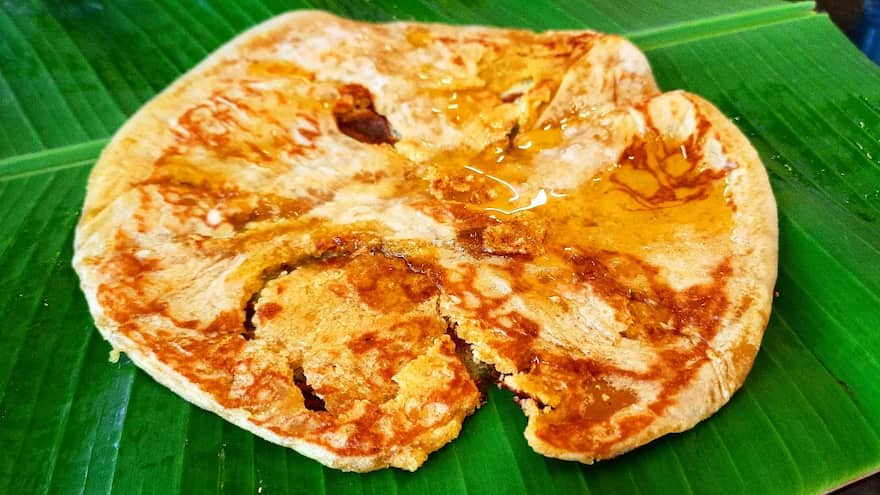Dussehra is celebrated throughout India with great pomp and show. Effigies of Ravana are burnt, symbolising the victory of good over evil. The festival of Dussehra succeeds nine days of Navratri, during which Maa Durga and her incarnations are worshipped. Thus, Devotees celebrate the nine holy days of Navratri by observing fast. While the Navratri focuses on eating light food, On the day of Dussehra, the celebrations and rituals are always followed with ‘bhogs’.
1. Fafda - Jalebi In Gujarat
Navratri is a major festival in Gujarat. Dandiya and Garba are performed on all nine days of ‘Navratri’ and on ‘Vijay dashmi’, the celebration of Dussehra. Gujarat celebrates Dussehra by feasting on ‘Fafda- Jalebi’, a cultural ritual many follow.
Long snaking queues are in motion long before the ‘Fafda-Jalebis’ are served at the city’s famous food joints. Most sweet shops prepare ‘Fafda-Jalebis’ in huge quantities to cater to the high demand.
Near Ahmedabad’s Manek Chowk lies the most famous and iconic food shop, Chandra Vilas, that serves this Dussehra special combo. On the day of Dussehra, no other food item is available for consumers except the Crispy Hot ‘Fafdas’ and sweet and delicious ‘Jalebis’. The wait time can run up to hours, with a queue going kilometres long.

I, too, waited in line to get my hands on this delicious preparation. It tasted divine. 'Fafdas', made of gram flour, although fried, are light on the stomach, and ’jalebis’ is the sweet deal behind the hour-long wait to try them at the city’s favourite place. Served with yellow ‘Kadhi’ and raw papaya salad, and with the festive vibe and joy on the faces of fellow food lovers, the experience of enjoying ‘Fafda’ with ‘Jalebi’ was memorable.
The hoarding was widely publicised at this 1905 established heritage food joint, Chandravila, States as below:
‘Why we eat 'Fafda' and ‘Jalebi’ on Dussehra?’
“In Hindu scriptures, it is a ritual that any fast must end eating food prepared from gram flour ('Fafda').
As per Hindu scriptures, the reason for eating ‘Jalebi’ is lord Ram loved a sweet called Shashkuli (Jalebi) and Lord Hanuman loved items prepared from gram flour. Medically it is good to eat jalebi during this season to control frequent migraine attacks due to hotter days and cooler nights. So, for our rituals and medical value, we need to relish ‘Fafda’ and ‘Jalebis’ on Dusshera. How wonderful is our deep-rooted culture…. Isn’t it?”
This being my first experience celebrating Dussehra in Ahmedabad, I was surprised to learn these facts about the culinary culture ritualistically followed in Ahmedabad and even across the different cities of Gujarat.
In many other North Indian cities, sweets like ‘Kheer’, ‘Jalebis’, and ‘Moti Choor Ladoos’ are prepared to offer to gods as prasadam and later eaten as a bhog.
Karnataka
In Karnataka, sweet dosa, also known as ‘Vella dosa’, is prepared using jaggery, coconut, rice flour and wheat flour. ‘Yereyappa’ or the ‘sweet appams’ are also prepared to offer as ‘prasadam’ to the deity.

Different kinds of ‘Payasams’ or kheer are prepared across South India; in Mysore, the Dussehra festival is a joyous and large-scale event with many cultural programs across different palaces. People of Mysore or Mysuru, thus, celebrate the Dussehra festival with many offerings. Mysore Pak, the famous gram flour based sweet dish, originated from the palace of Mysore. Therefore, no one should miss out on enjoying this melt-in-the-mouth sweet delicacy of Mysore. Different types of ‘Holige’ (Puran Poli) too are prepared in Karnataka to celebrate the festivities.
Paan
Another interesting custom is to offer paan (betel leaves) to Lord Hanuman on the occasion of Dussehra. Later, the paan is also consumed as a celebration of the victory of good over evil. Per belief, Paan is favoured by Lord Hanuman, thus giving rise to this custom.
Paan, being a digestif, also helps digestion by making it an ideal customary intake after the post-Navratri feasting on the festival of Dussehra.
West Bengal
In West Bengal, Vijay Dashmi or Dashami comes right after the days of Durga Pujo. Thus, celebrations around the festivals are high on energy and spiritualism and calls for festive feasting. Being a state known for its sweet dishes, various ‘Chena’ sweets like ‘Rosagulla’, Sondesh, ‘Cham’, and’ Payesh’ can’t be missed out. ‘Malpuas’, too, are prepared for Dashami. Besides sweets, an attractive ritualistic offer of fish is offered to Maa Durga and Maa Kali. Lots of delicious fish curry and ‘bhath’ are prepared, with the favourite being a Hilsa preparation or a Rohu Macher Jhol, amongst other traditional Bengali dishes, to be consumed during the most significant festival celebrated in Bengal.
Throughout India, similar celebrations occur, with each state having its special items prepared during Dussehra. Many rituals regarding the culinary offerings made to the deities differ from community to community, and every household, or clan, may have their traditions and rituals.
This is the beauty of India, its culture and its cuisines. After experiencing the Dussehra feast in Ahmedabad last year, this year, I am excited to celebrate the grand Dasara festivities in Mysuru. I would be feeding up on Mysore Pak. Let us know what you are going to feast on this Dussehra.
Happy Dussehra!
Sidharth Bhan Gupta is a Hospitality/F&B Consultant travelling across India exploring regional cuisines.


